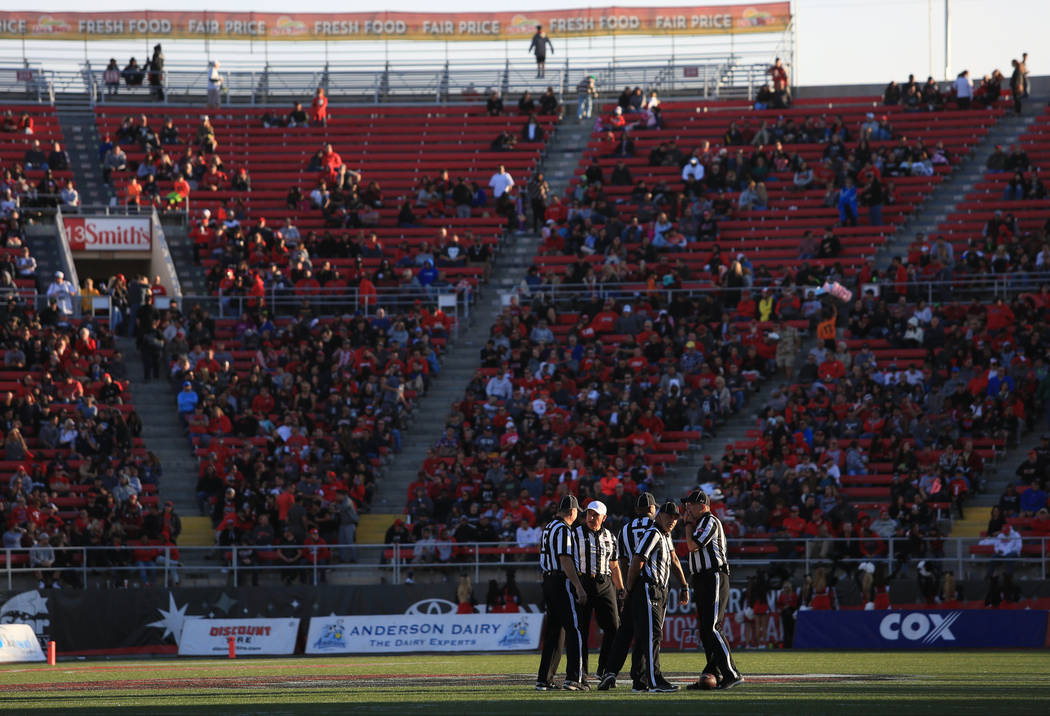Mountain West future on line as TV talks take place
Mountain West commissioner Craig Thompson oversees a league with needs as varied as its topography, and that is especially the case when it comes to deciding which TV and multimedia rights contracts make the most sense as negotiations take place for a new set of deals.
Some athletic directors and presidents place the emphasis on national and regional exposure and over having control of game starts. Other administrators, particularly those in the eastern part of the conference, are tired of 10 p.m. Mountain time tipoffs for basketball games and are willing to go more of a digital rather than linear TV route to make it happen.
It’s possible, perhaps even likely, the Mountain West will be able to accommodate all parties as it negotiates its new deals.
Sports media expert Joel Lulla, a lecturer at Texas, said he thinks a marriage between the Mountain West and the growing ESPN-Plus digital service makes sense.
The American Athletic Conference agreed to a 12-year, $1 billion deal with ESPN that includes a major portion of games being played on the digital format, setting the precedent of what’s expected to come. It’s about four times what the American made on its previous ESPN deal, but AAC fans who want to see their favorite team must pay $4.99 per month to watch.
“The number the American Athletic Conference got, it’s a little misleading because the AAC is going to have to produce a lot of events, and that’s going to cost millions of dollars,” said Lulla, the former head of ABC Sports’ legal and business department and a lead counsel at IMG. “But if ESPN-Plus and ESPN are not interested in the Mountain West, they’ve got a big problem because I don’t know who else is going to step up in any real way.
“They’re currently between the CBS deal and the ESPN deal somewhere in the $16, $17 million-a-year range. If ESPN-Plus is interested, they could double that easily. If ESPN is not interested, they could be looking at a 50 percent haircut.”
Rise of ESPN-Plus
The Mountain West’s current deals with CBS Sports, ESPN and AT&T SportsNet expires in 2020, paying each school about $1.1 million each year. CBS Sports had the first negotiating window.
Sports Business Journal reported that the NFL Network, which agreed to a four-year contract with Conference USA to air game beginning this season, is interested in a similar deal with the Mountain West. Financial terms of the C-USA deal were not announced.
The Mountain West is providing few clues on how talks with potential partners are transpiring.
“In response to inquiries regarding the status of current Mountain West media rights negotiations, the Conference will have no further comment until such time as we are prepared to make an announcement,” Thompson said in a statement.
UNLV athletic director Desiree Reed-Francois deferred any comments to the league. Reed-Francois, however, said last year she would like to see a combination of a linear and digital contract.
“We need attractive start times because it’s important our fans can come to our games,” she said. “Resources, of course, are very important, and I’m really looking forward to the Mountain West continuing to be an innovative leader in this space without sacrificing the opportunity to showcase our institution, the community and the student-athlete achievement.”
The ways of delivering that exposure figure to change as viewing habits evolve.
Many viewers already have cut the cable cord or canceled the satellite hookup for an a la carte choice through online packages. Options such as ESPN-Plus could be the next wave rather than traditional outlets like the ESPN family of over-the-air networks.
“The need to cut costs and deliver content to niche audiences is really what ESPN-Plus seems poised to,” said Southern California professor and sports business consultant David Carter. “They certainly have been emboldened by the early and demonstrated success of the UFC deal (five years, $1.5 billion), and you may just start to see other entities move in that direction as well because ESPN-Plus is becoming a mainstay already, and there’s no stigma attached to being on a digital platform.”
Uneven playing field
No matter which TV/multimedia rights the Mountain West sign onto, the conference won’t come close to narrowing the division between the Power Five leagues and the rest.
The Atlantic Coast Conference has the lowest-paying deals among the Power Fives, and those schools make an average of $26.6 million. That dwarfs even the American’s new deal with ESPN, which will pay an average of $6.94 million to the member institutions beginning in 2020.
So the financial difficulties that exist now for the Mountain West might improve some, but they won’t disappear.
And in the long term, what is the current financial divide might become an actual division. The power conferences could create their own playing field and face only each other, forcing UNLV and other similar schools into a lower division.
“Frankly, if you look at the rulings and developments of the NCAA over the years, it seems to be trending toward that occurring,” Carter said. “So I think what you might end up many years down the road having (is) 50 schools really playing top-level, professional-esque Division I football and basketball and maybe the rest playing the kind of sport the NCAA envisioned all along, which was balancing academics and athletics.”
More Rebels: Follow at reviewjournal.com/Rebels and @RJ_Sports on Twitter.
Contact Mark Anderson at manderson@reviewjournal.com. Follow @markanderson65 on Twitter.
Current MW partners
AT&T SportsNet — The regional carrier broadcasts games CBS or ESPN don't pick up.
CBS — Most events are on CBS Sports Network, but some appear on the network.
ESPN — Broadcasts games on its various networks as well as its digital format, ESPN-Plus.
Potential partners
AT&T SportsNet — Having a regional partner is crucial for games that aren't televised nationally.
CBS — Had the first negotiating window with the Mountain West.
ESPN — The next deal probably will include many more games on ESPN-Plus.
NFL Network — Got into the college game with a four-year deal with Conference USA.























